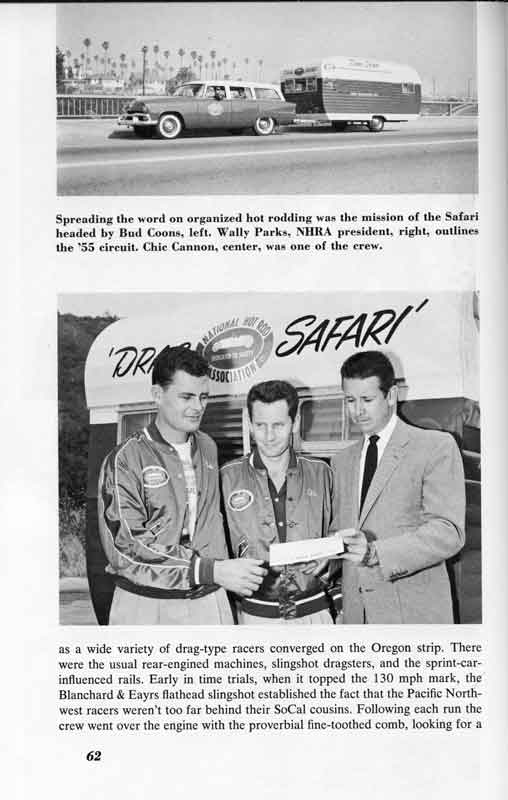Drag Racing, Yesterday and Today; the Story of the World’s Fastest Sport by Wally Parks
Submitted by Admin on

Feb 18, 2008
Book review by Richard Parks, photographic consultant Roger Rohrdanz


Drag Racing, Yesterday and Today; the Story of the World’s Fastest Sport, by Wally Parks, is the first and only book by the founder of the National Hot Rod Association. Printed and published by Trident Press in New York City in 1966, this gem of a book has long been out of print and there are no book stores currently carrying it for sale. At best you can find it on eBay and on rare occasions, in a used book store. The original price was $4.95 and for years was purchased mainly by drag racing fans and family. But like all things that have true value, over time such works become classics and a signed edition would probably sell for about one hundred times its original cost. I have had three or four of the books in my library and mysteriously, they tend to disappear, hopefully into the hands of family and collectors who value them. To be fair to the readers, Wally Parks was my father and thus it must be pointed out that I may have some tendency to be partial. That being said, let’s look at the mechanics of the book and then an appraisal of its literary worth. Wally Parks is the main author, but Lyle Kenyon Engel is the co-author and producer. Dan Roulston, George Engel and Marla Ray did research, preparation and review of the material. Drag Racing, Yesterday and Today is a hard-bound, red covered book with 240 pages, a dust cover jacket and a high-quality cloth binding. There is no ISBN number assigned, but the Library of Congress Catalog number is 66-16184, though as I said, the book is very rare and not in any book store. Dad told me once that 5000 copies were produced, but I can’t verify that for certainty. There is a Table of Contents, a three page preface by Wally Parks, ten chapters, a five-page glossary of terms and an outstanding ten-page index. There are 170 black and white photographs, but none in color. The pages are a light bond, not the waxed paper that you find in quality pictorials, but the paper appears to be acid free and has not yellowed with age.
Drag Racing, Yesterday and Today has survived the test of time because it is a classic. The dust cover jacket is white, black and red and is often lost, torn or destroyed. Losing the dust cover jacket has not decreased the value of the book, but in the future it will. There is a demand for another reprinting and the estate is considering doing just that. The book is maroon colored with an embossed outline of a dragster. The cloth binding is superior and that’s one reason that the copies of Drag Racing, Yesterday and Today have survived for four decades in such good shape. Nearly all the copies that I’ve seen are in very good condition, though few dust cover jackets have survived. Yes, I’m nagging the owner, take care of that dust cover jacket or the value of your copy will not rise as fast in the future as someone who has a well preserved sleeve. Parks evidently looked into the future and guessed, correctly it seems, that readers would welcome a glossary of terms. Many of the terms are still in use today and a few seem quaint and archaic. The index is first class, ten pages and precise. Whoever did the index is a master historian or secretary without equal. The photographs are all in black and white. They are as clear and crisp looking as is possible on non-waxed photographic paper. This is one part of the book that could have been improved upon. The captions are full, to the point and explanatory. The photographs could stand alone, without the text, and yet still tell the story well. Parks wrote the first few chapters and you can see an almost poetical style and zeal. The rest of the book is a collaboration with the co-author and the structure becomes more fact-filled. Perhaps the urge to fill this tiny book with all the knowledge of the new sport of drag racing made it imperative to skimp on the lyrical feelings so evident at the beginning. Regardless, the book only suffers a slight reduction in readability towards the end. By and large, the writing and construction are superior to what we have today.
Drag racing evolved out of dry lakes land speed and illegal street racing. Wally Parks had a burning desire to see order brought forth from chaos. His talent lay in inspiring others to work together for the same goal, to save lives and create a sport that allowed men and women to build and race cars capable of great speed and performance. He wasn’t the only pioneer in this field. There were brilliant men and women who worked to make drag racing a sport that would become respected and loved by millions. Drag Racing, Yesterday and Today tells the story of drag racing from its roots to the acceptance that it achieved by 1966, the year that the book was released. A lot has happened since then to cement drag racing’s place in the pantheon of the world’s automotive sports. Yet this book needs no other additions to explain to the public what inspired drag racing and why it is so important to men and women today. The first two chapters describe the early dry lakes and land speed racing. Many of the men and women, such as Ak Miller, Stu Hilborn, Otto Crocker, Karl and Veda Orr, Lou Baney, Chuck Potvin, Vic Edelbrock, Don Blair and others became well-known and prospered in manufacturing or other types of racing. Chapter three tells about the need to find racing venues closer to the cities in an effort to get young people to give up illegal street racing and race on safe and sanctioned drag strips. Chapter four talks about the Safety Safari, a group of young men sent out by Parks and the fledgling National Hot Rod Association (NHRA) that Parks created to teach car clubs how to put on safe drag races. Bud Coons led a group composed of Eric Rickman, Chick Cannon and Bud Evans from one city to another across America to bring the NHRA’s principles to local car clubs. Chapters five through ten explore the rapid growth and professionalization of drag racing, beyond the wildest dreams of the early founders. Someday a sequel will be written that will bring the public up to date on the events that happened in the four decades after the book was published. Very likely a second edition will be published. If you are fortunate enough to come across an original copy of Drag Racing, Yesterday and Today, buy it and add it to your library.
Gone Racin’ is at [email protected].
A page from the book

